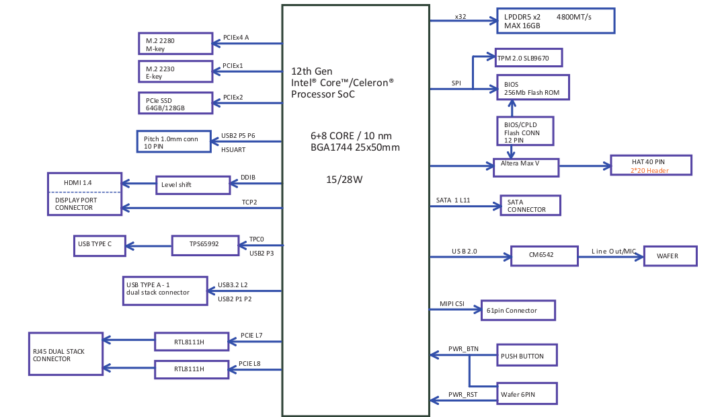AAEON’s UP Squared i12 is a single board computer with the same dimensions as the UP Squared (Apollo Lake) and UP Squared V2 (Elkhart Lake) boards, and mostly the same ports layout, but powered by a more powerful 12th generation Intel Alder Lake-P processor from a Celeron 7305E up to an Intel Core i7-1270PE.
The board comes with up to 8 or 16GB LPDDR5 memory, SATA and NVMe storage support, triple 4K display support through HDMI, DisplayPort and USB-C interfaces, dual Gigabit Ethernet, a few USB boards, and some wafers and headers such as a Raspberry Pi-compatible GPIO header.
UP Squared i12 specifications:
- 12th generation Alder Lake-P SoC:
- Intel Core i7-1270PE 12-core/16-thread processor @ 3.30GHz / 4.50GHz (Turbo) with 96EU Intel Xe graphics – PBP: 28W, up to 64W MTP
- Intel Core i5-1250PE 12-core/16-thread processor @ 3.20GHz / 4.40GHz (Turbo) with 80EU Intel Xe graphics – PBP: 28W, up to 64W MTP
- Intel Core i3-1220PE 8-core/12-thread processor @ 3.10GHz / 4.20GHz (Turbo) with 48EU Intel UHD graphics – PBP: 28W, up to 64W MTP
- Intel Celeron 7305E penta-core processor @ 3.10GHz / 4.20GHz (Turbo) with 48EU Intel UHD graphics – PBP: 15W, up o 55W MTP
- System Memory – Up to 8GB onboard LPDDR5 (the block diagram says up to 16GB)
- Storage
- M.2 2280 M-Key socket (See Expansion section)
- 1x SATA III
- The block diagram seems to indicate there’s also a 64GB/128GB SSD connected over a PCIe x2 interface, and I assume, soldered to the board
- Video Output
- HDMI 1.4b and DisplayPort 1.2 stack connector
- DisplayPort 1.4a via USB Type-C port
- Up to three 4Kp60 independent monitors
- Audio – 6-pin audio wafer (Line out + MIC in)
- Camera – 2x MIPI-CSI via 61-Pin FPC connector
- Networking
- Dual Gigabit Ethernet RJ45 ports via RTL8111H controllers
- Optional wireless via M.2 socket (See Expansion section)
- USB
- 2x USB 3.2 Gen 2 Type-A ports
- 1x USB 3.2 Gen 2 Type-C port with DP 1.4 Alt. mode
- Expansion
- M.2 2280 M-Key socket for SSD (PCIe Gen 4.0 x4)
- M.2 2230 E-Key socket for wireless (CNVI & PCIe Gen 3.0 [x1])
- 40-pin Raspberry Pi HAT header with GPIOs handled through an Altera Max V FPGA
- 10-pin header with 2x USB 2.0 and 1x UART
- Security – Onboard TPM 2.0
- Misc
- 2-pin fan wafer (12V)
- 2-pin RTC battery wafer
- 6-pin front panel
- RTC
- Power Supply – 12V DC-in; AT/ATX (AT as default) type
- Power Consumption (Typical) – 26W~39W
- Dimensions – 90 x 85.6mm
- Weight – 270 grams
- Temperature Range – 0°C to 60°C with 0.5m/s airflow
- Humidity – 0% ~ 90% relative humidity, non-condensing
- MTBF – 522,716 Hours
- Certifications – CE/FCC Class A, RoHS Compliant, REACH
AAEON provides support for Windows 10 IoT Enterprise LTSC 2021, Ubuntu 22.04, and Yocto 4.0. Another way to look at the board is as a more compact and likely cheaper alternative to the UP Xtreme i12 SBC that comes with the same choice of processors, but a wider range of I/Os, up to 32GB RAM, etc…
The company says the features set of the board should make it suitable for smart retail, healthcare imaging, and well as various machine vision projects. Documentation should eventually be posted on the UP board website, but at the time of writing, the UP Squared i12 is not listed there.

The company did not provide availability and pricing information, but for reference, the UP Xtreme i12 SBC currently sells for $399.00 and up with 8GB RAM, and the UP Squared i12 price should be somewhat lower based on the specifications. A few more details may be found on the product page.

Jean-Luc started CNX Software in 2010 as a part-time endeavor, before quitting his job as a software engineering manager, and starting to write daily news, and reviews full time later in 2011.
Support CNX Software! Donate via cryptocurrencies, become a Patron on Patreon, or purchase goods on Amazon or Aliexpress








I would only be interested in this for Proxmox/other virtualization use. For industrial use I use different more hardened/packaged offerings.
So… 1 Gb NICs = Pass for my use.
Those inductors though. :face palm:
I didn’t realize they were the inductors, I initially thought it was a large heat sink seen from profile. But you’re totally right, their position matches the ones marked R21! what a mess! At this point I’d consider this a design failure! At that size at least they ought to have been placed on the other side! I already didn’t like their previous UP squared for its poor usage of PCB area, some connectors are very tall, some areas are totally flat, it’s by design a waste of space. But here they broke a record!
I should point out that you’re not going to be using that board without a heatsink, which would be as tall or taller than those inductors.
Honestly the real issue is actually the display and ethernet ports, which are much too tall.
or on the wrong side of the board.
No 3.5″ SBC manufacturer uses such insane coils. Just drop the board on a flat heat sink and you’re done.
From $399.00 to $1,039.00 unit price. So it’s definitely for business/industrial customers, buying it by the palette and getting a significant discount with support up to 2037.
The support duration clearly is one of their big strengths. The board’s layout with the huge inductors however…
The whole “Up Board” program is pretty abysmal. A bunch of people who bought the early/small versions just got hung out to dry without any support, little to no buildout of support packages.
Not too uncommon in the SBC world, of course, but shockingly bad for the UpBoards.
Dead links everywhere. Forums full of angry people. Intel just cannot get *anything* right these days …